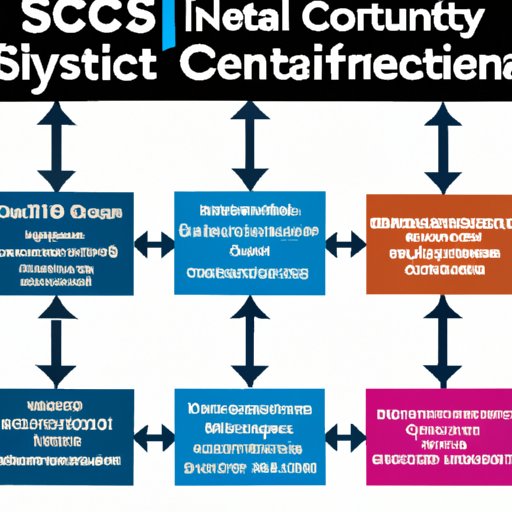Introduction
A cybersecurity framework is an organized set of policies, procedures, and guidelines that are designed to protect an organization’s sensitive information. It is an essential tool for organizations to ensure the security of their networks and systems, as well as help them become compliant with applicable laws and regulations. In this article, we will explore what a cybersecurity framework is, why it is important, the components of a cybersecurity framework, how to implement a cybersecurity framework, and the benefits of establishing a cybersecurity framework.
Exploring the Basics of Cybersecurity Frameworks
A cybersecurity framework is a comprehensive approach to managing the security of an organization’s networks, systems, and data. It is composed of various components, including policies, procedures, tools, and technologies. The framework provides a roadmap for organizations to follow in order to protect their assets and reduce risk.
The framework is designed to be customized to the specific needs of the organization. It should address the organization’s goals, objectives, risk tolerance level, and resources available. The framework should also provide guidance on how to respond to incidents, detect threats, and mitigate risks.

Understanding the Components of a Cybersecurity Framework
The components of a cybersecurity framework include establishing policies and procedures, selecting appropriate security controls, and implementing effective auditing and monitoring. Establishing policies and procedures is critical for ensuring that everyone in the organization understands the rules and guidelines for handling sensitive information. This includes defining acceptable use policies, access control policies, and incident response plans.
Selecting appropriate security controls is also important. Security controls are measures used to protect the organization’s assets and reduce risk. These can include firewalls, antivirus software, encryption, authentication methods, and more. The security controls must be regularly evaluated and updated to ensure they remain effective.
Finally, effective auditing and monitoring are necessary to ensure that the security controls are working properly. Auditing involves regularly assessing the security posture of the organization and identifying areas of improvement. Monitoring involves tracking activities within the network and responding to suspicious activity.

An Overview of the Different Types of Cybersecurity Frameworks
There are several different types of cybersecurity frameworks available. The most popular ones include the NIST Cybersecurity Framework, ISO/IEC 27001, CIS Critical Security Controls, and SANS Top 20 Critical Security Controls. Each of these frameworks has its own set of guidelines and best practices that organizations should follow.
The NIST Cybersecurity Framework was developed by the National Institute of Standards and Technology (NIST). It consists of five core functions: identify, protect, detect, respond, and recover. It also includes a set of standards, guidelines, and best practices that organizations can use to improve their security posture.
ISO/IEC 27001 is an international standard for information security management. It provides a framework for organizations to develop and implement a security management system. It covers topics such as risk assessment, asset management, access control, and incident response.
The CIS Critical Security Controls are a set of 20 controls that organizations can use to protect their networks and systems from cyber attacks. These controls cover topics such as vulnerability management, malware protection, incident response, and password management.
Finally, the SANS Top 20 Critical Security Controls are another set of 20 controls that organizations can use to protect their networks and systems. These controls focus on topics such as patch management, user access control, and network monitoring.
A Look at How to Implement a Cybersecurity Framework
Implementing a cybersecurity framework requires a few steps. First, organizations need to assess their current security posture. This involves reviewing existing policies, procedures, and security controls to identify any gaps or areas of improvement. Second, organizations need to identify any gaps and areas of improvement. This could involve updating policies, procedures, and security controls, or establishing new ones.
Third, organizations need to develop and implement a plan. This plan should include a timeline and budget for implementation, as well as a strategy for addressing any gaps or areas of improvement identified. Finally, organizations need to ensure that the plan is regularly monitored and updated as needed.
Developing a Comprehensive Cybersecurity Framework Plan
Once the organization has identified any gaps or areas of improvement, they need to develop a comprehensive cybersecurity framework plan. This plan should include establishing goals and objectives, defining scope and risk tolerance, and identifying resources needed for implementation. It should also include a timeline and budget for implementation, as well as a strategy for addressing any gaps or areas of improvement identified.
The plan should also include a process for periodically assessing the security posture of the organization and making updates as needed. This process should include regular reviews of policies, procedures, and security controls, as well as regular audits of the organization’s networks and systems.

Examining the Benefits of Establishing a Cybersecurity Framework
Establishing a cybersecurity framework can bring many benefits to an organization. One of the key benefits is improved visibility. With a comprehensive framework in place, organizations can easily monitor their networks and systems for potential threats and vulnerabilities. This improved visibility can help organizations identify and respond to threats quickly and effectively.
Another key benefit is enhanced security and compliance. With a comprehensive framework in place, organizations can ensure that their networks and systems are secure and compliant with applicable laws and regulations. This can help organizations avoid costly fines and penalties for non-compliance.
Finally, establishing a cybersecurity framework can help organizations save money. By implementing a framework, organizations can reduce the time and effort required to manage their security posture. This can lead to cost savings in terms of labor and resources.
Conclusion
In conclusion, a cybersecurity framework is an essential tool for organizations to ensure the security of their networks and systems, as well as help them become compliant with applicable laws and regulations. A comprehensive framework consists of various components, including policies, procedures, tools, and technologies. There are several different types of frameworks available, each with its own set of guidelines and best practices. Implementing a framework requires assessing the organization’s current security posture, identifying gaps and areas of improvement, and developing and implementing a plan. Establishing a framework can bring many benefits, including improved visibility, enhanced security and compliance, and cost savings.
(Note: Is this article not meeting your expectations? Do you have knowledge or insights to share? Unlock new opportunities and expand your reach by joining our authors team. Click Registration to join us and share your expertise with our readers.)
